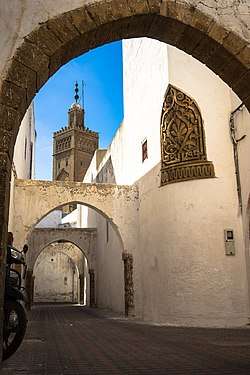Hubous
The Hubous (Arabic: الحُبوس al-Hubous or حَي الأَحْباس Hay al-Ahbaas), or colloquially Habous, is one of the older neighborhoods of Casablanca, Morocco. Its development dates back to 1916, in the early stages of the French protectorate. The neighborhood is a cultural and religious center for Casablanca and for Morocco, as it hosts the Moroccan Ministry of Islamic Affairs as well as bookstores of important Moroccan and Arabic publishing houses.[1] The many traditional and historic buildings also make the Hubous a popular tourist destination.[1]
Hubous | |
|---|---|
 A typical view from within the alleys of the Hubous neighborhood in Casablanca |
Name
The word ḥubous (حُبوس) in Arabic means a waqf (وَقْف), an inalienable charitable real estate endowment for Islamic religious purposes or charity. A Moroccan Jewish man named Haim Ben-Dahan apparently gifted the land to the sultan, who allocated it to the Ministry of Islamic Affairs.[2]
History

In 1916, almost a decade after the French invasion and occupation of Casablanca and four years after the official establishment of the French protectorate, General Lyautey's handpicked urban planner Henri Prost and his team decided to build a "nouvele ville indigène," a new medina near the sultan's palace to the east of the new center.[3]
The Mosque of Sultan Yusuf was designed by Auguste Cadet and Edmond Brion, and the Mosque of Sultan Muhammad Bin Yusuf was designed by Cadet and built from 1934 to 1936.
Mahkamat al-Pasha, one of the most important buildings in the Hubous, was built 1941–1942.[4]
References
- "حي الأحباس". www.aljazeera.net. Retrieved 2019-05-11.
- "حي الحبوس.. وجهة المثقفين للبحث عن الكنوز الفكـرية". مغرس. Retrieved 2019-05-12.
- Hodebert, Laurent. ""Laprade et Prost, du Maroc à Génissiat, du sol des villes aux édifices", journal de l'exposition "De la construction au récit" au CAUE 74". Journal de l'exposition "De la construction au récit, être de son temps et de son lieu pour l'architecture du XXe siècle".CS1 maint: extra punctuation (link)
- "باشا البيضاء يقرر سنة 1930 إحداث محكمة جديدة بمنطقة الأحباس". مغرس (in Arabic). Retrieved 2019-05-11.